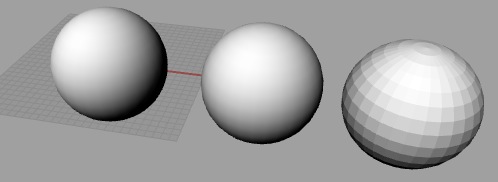TAPESTRY: The Art of Representation and Abstraction
Rhino + V-Ray: Smoothing
Smoothing
Some programs permit you to control smoothing (aka Flat vs Phong shading) as a rendering attribute (so, applied to all objects in the scene), while others (SketchUp, form-Z) make it an attribute of the geometry within the application, usually in terms of the angle between adjacent planes.
Rhino permits you to render the scene "flat" or smoothed, but you may wish to have some of both. Here's how to understand what's going on.
Rhino Render meshes
Rhino uses a mathematical representation for shapes, called NURBS. They're exact representations, not faceted into polygons. However, to render, it turns all that perfect geometry into faceted "render meshes", and then it smooths the result. In some programs you can control how sensitive the smoothing is relative to angle. We can control the render mesh complexity in Rhino, but not the smoothing. However, smoothing depends on groups of polygons being rendered together, and we can "ExtractRenderMesh" on a NURBS object (like a surface of revolution) and then "Unweld" the resulting group of polygons (the render mesh) to make a bunch of individual polygons, each of which renders "flat".

The three spheres are (left to right): (1) the original sphere primitive (an 'exact' geometry, (2) the smoothly rendered mesh from "ExtractRenderMesh" (a tessellated geometry), and (3) the flat-rendered facets after the mesh was UNWELDed.
for more info: http://en.wiki.mcneel.com/default.aspx/McNeel/MeshFAQ.html or http://www.hydraulicdesign.net/meshes.htm.
Last updated: April, 2014
